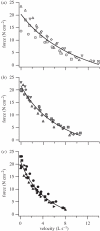The weak link: do muscle properties determine locomotor performance in frogs?
- PMID: 21502120
- PMCID: PMC3130445
- DOI: 10.1098/rstb.2010.0326
The weak link: do muscle properties determine locomotor performance in frogs?
Abstract
Muscles power movement, yet the conceptual link between muscle performance and locomotor performance is poorly developed. Frog jumping provides an ideal system to probe the relationship between muscle capacity and locomotor performance, because a jump is a single discrete event and mechanical power output is a critical determinant of jump distance. We tested the hypothesis that interspecific variation in jump performance could be explained by variability in available muscle power. We used force plate ergometry to measure power produced during jumping in Cuban tree frogs (Osteopilus septentrionalis), leopard frogs (Rana pipiens) and cane toads (Bufo marinus). We also measured peak isotonic power output in isolated plantaris muscles for each species. As expected, jump performance varied widely. Osteopilus septentrionalis developed peak power outputs of 1047.0 ± 119.7 W kg(-1) hindlimb muscle mass, about five times that of B. marinus (198.5 ± 54.5 W kg(-1)). Values for R. pipiens were intermediate (543.9 ± 96.2 W kg(-1)). These differences in jump power were not matched by differences in available muscle power, which were 312.7 ± 28.9, 321.8 ± 48.5 and 262.8 ± 23.2 W kg(-1) muscle mass for O. septentrionalis, R. pipiens and B. marinus, respectively. The lack of correlation between available muscle power and jump power suggests that non-muscular mechanisms (e.g. elastic energy storage) can obscure the link between muscle mechanical performance and locomotor performance.
Figures




References
-
- Lutz G. J., Rome L. C. 1994. Built for jumping: the design of the frog muscular system. Science 263, 370–37210.1126/science.8278808 (doi:10.1126/science.8278808) - DOI - DOI - PubMed
-
- Marsh R. L. 1994. Advances in veterinary science and comparative medicine (ed. Jones J. H.), pp. 51–111 New York, NY: Academic Press - PubMed
-
- Marsh R. L., John-Alder J. B. 1994. Jumping performance of hylid frogs measured with high-speed cine film. J. Exp. Biol. 188, 131–141 - PubMed
-
- Cavagna G. A. 1975. Force plates as ergometers. J. Appl. Physiol. 39, 174–179 - PubMed
-
- Lutz G. J., Bremner S., Lajevardi N., Lieber R. L., Rome L. C. 1998. Quantitative analysis of muscle fibre type and myosin heavy chain distribution in the frog hindlimb: implications for locomotory design. J. Muscle Res. Cell Motil. 19, 717–73110.1023/A:1005466432372 (doi:10.1023/A:1005466432372) - DOI - DOI - PubMed
Publication types
MeSH terms
Grants and funding
LinkOut - more resources
Full Text Sources
Research Materials
